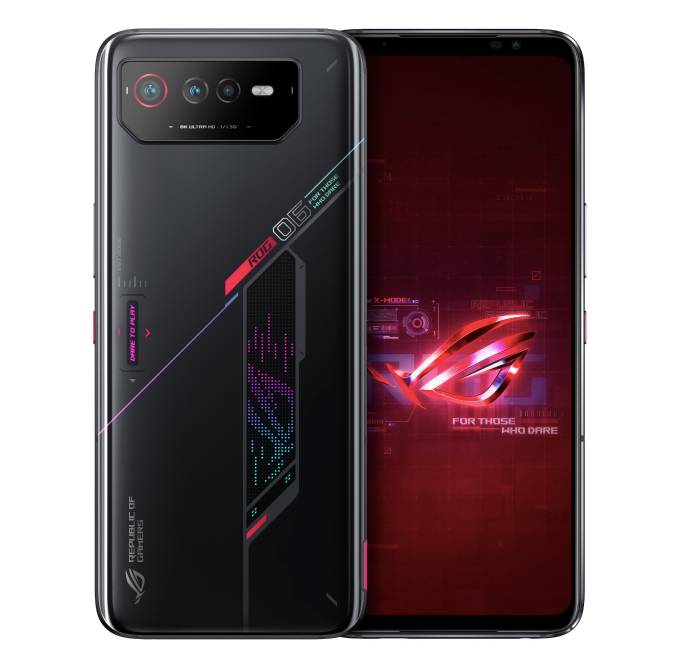Mobile gaming made more responsive with ROG Phone 6

Phone too sluggish for your game? Can’t show off your lightning-fast reflexes? Time to stop flinging your phone against the wall — the new ROG Phone 6 and Phone 6 Pro looks to be crazy responsive beyond belief. On paper, at least.
What’s of interest is the 6.78" Samsung AMOLED HDR10+ display (tuned by Pixelworks) that delivers a 165 Hz refresh rate and a whopping 720 Hz touch-sampling rate and 23 ms ultra-low touch latency. In English, this means that I can’t blame my phone for being a piece of turd the next time I rage quit an online PvP game. You also have the freedom to set the refresh rate within a range of 60 Hz, 90 Hz, 120 Hz, 144 Hz, or 165 Hz.

Accompanying the display is a symmetrical pair of seven-magnet, forward-firing speakers and — surprise, surprise — a convenient 3.5 mm headphone jack. The system has been optimised with the input of Dirac and also features the Dirac Virtuo spatial audio algorithms for immersive stereo sound. The phone also features Snapdragon Sound technology for low latency gaming and music streaming.
As a gaming phone, the rest of the hardware is more or less predictable: a Snapdragon 8+ Gen 1 (up to 3.2 GHz) SoC that Asus says offers 50 per cent more performance over the ROG Phone 5, up to 16 GB of LPDDR5 RAM (18 GB on the Pro), and up to 256 GB of storage (512 GB on the Pro). The upgraded GameCool 6 cooling system has a 30 per cent larger vapour chamber and 85 per cent larger graphite sheets, along with a centred-CPU design to improve heat dissipation.

For added cooling performance, you can get the optional AeroActive Cooler 6 with its AI-powered thermoelectric cooler and fan combo, which increases airflow directly to hotspots and lowers the surface temperature by up to 25°C. It also adds four extra physical button controls. The cooler is part of a range of new accessories for the Phone 6 series like the ROG Kunai 3 Gamepad to enrich the gaming experience.
The touch-responsive AirTrigger 6 has also been upgraded and the ultrasonic sensors support various gestures, which enables new features like Dual Action (tap two buttons at once), Press and Lift (down and up with one action), and Gyroscope Aiming (tilt to aim).
While the camera is often an afterthought in a gaming phone, the triple-camera system features a Sony IMX766 50 MP main wide-angle camera, an ultrawide 13 MP second camera, and a macro camera, which isn’t half-bad at all. While the IMX766 isn’t used on the cream-of-the-crop cameras, they are found (or some variant of it) in phones well-regarded for their camera performances like the Oppo Find X3 Pro and Vivo X70 Pro.
Last but not least, the monster 6,000 mAh battery features advanced battery-care features for better battery performance and an extended lifespan, and there’s also a 65-watt HyperCharge adapter for rapid charging.

The Phone 6 and the Phone 6 Pro have relatively minor differences. The Pro has an additional 2GB of RAM, and while the regular Phone 6 has an Aura RGB display on the back, it is replaced by a 2-inch OLED display with six customisable scenarios on the Pro.
If you’re tired of pouring through the interwebs to find wireless headphones that aren’t laggy for gaming, the Cetra True Wireless Pro , ROG Cetra True Wireless , and ROG Delta S Wireless are candidates (among a host of headphones announcements) that look best suited to the task.
ROG Cetra True Wireless low-latency wireless audio is a more ‘basic’ solution that offers better synchronisation with onscreen visuals. If you want more, the new Cetra True Wireless Pro (wired USB-C and wireless) features ESS 9820 Quad DAC, ANC, Snapdragon Sound and an AI noise-cancelling microphone.
Alternatively, there’s the ROG Delta S Wireless, which is the first ROG dual-mode (2.4Ghz and Bluetooth) wireless gaming headset if you need to be connected to your computer as well. It also features concealed AI Beamforming Microphones with AI noise cancellation.

The Phone 6 is available in Phantom Black and Storm White and comes equipped with Aura RGB lighting on the back, up to 16 GB of LPDDR5 RAM and up to 512 GB of storage. The ROG Phone 6 Pro is available in Storm White and features a colour ROG Vision mini-display on the back, 18 GB of LPDDR5 RAM and 512 GB of storage.
Local availability and prices of the ROG Phone 6 and ROG Phone 6 Pro will only be announced at a later date. If we go by Europe prices, it’s €999 (S$1,438) for the Phone 6 (12GB+256GB), €1,149 for the Phone 6 (16GB/512GB) and €1,299 for the Phone 6 Pro.
The Cetra True Wireless is priced at $169 and is available now. Availability and prices for the Pro version and Delta S Wireless have yet to be announced.
[UPDATE] The ROG Phone 6 (12GB+256GB) will not be coming to Singapore. That's not bad news at all, because the ROG Phone 6 (16GB+512GB) is available here for practically the price tag of the 12GB version – $1,399.
The ROG Phone 6 Pro (18GB+512GB) is priced at $1,799.
Probably one of the better pricing tiers we've seen because those who want the absolute best are going to buy the 18GB version anyway and the $1,399 price tag for the 16GB version is pretty attractive.
ALSO READ: Xiaomi unveils its first Leica-branded phones, the 12S, 12S Pro and 12S Ultra
This article was first published in Potions.sg.